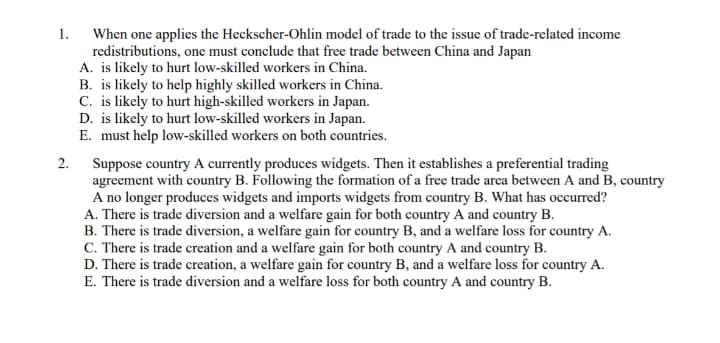When one applies the Heckscher-Ohlin model of trade to the issue of trade-related income redistributions, one must conclude that free trade between China and Japan A. is likely to hurt low-skilled workers in China. B. is likely to help highly skilled workers in China. C. is likely to hurt high-skilled workers in Japan. D. is likely to hurt low-skilled workers in Japan. E. must help low-skilled workers on both countries. 1.
When one applies the Heckscher-Ohlin model of trade to the issue of trade-related income redistributions, one must conclude that free trade between China and Japan A. is likely to hurt low-skilled workers in China. B. is likely to help highly skilled workers in China. C. is likely to hurt high-skilled workers in Japan. D. is likely to hurt low-skilled workers in Japan. E. must help low-skilled workers on both countries. 1.
Principles of Economics 2e
2nd Edition
ISBN:9781947172364
Author:Steven A. Greenlaw; David Shapiro
Publisher:Steven A. Greenlaw; David Shapiro
Chapter33: International Trade
Section: Chapter Questions
Problem 35P: If trade increases world GDP by 1 per year, what is the global impact of this increase over 10...
Related questions
Question
5

Transcribed Image Text:When one applies the Heckscher-Ohlin model of trade to the issue of trade-related income
redistributions, one must conclude that free trade between China and Japan
A. is likely to hurt low-skilled workers in China.
B. is likely to help highly skilled workers in China.
C. is likely to hurt high-skilled workers in Japan.
D. is likely to hurt low-skilled workers in Japan.
E. must help low-skilled workers on both countries.
1.
2. Suppose country A currently produces widgets. Then it establishes a preferential trading
agreement with country B. Following the formation of a free trade area between A and B, country
A no longer produces widgets and imports widgets from country B. What has occurred?
A. There is trade diversion and a welfare gain for both country A and country B.
B. There is trade diversion, a welfare gain for country B, and a welfare loss for country A.
C. There is trade creation and a welfare gain for both country A and country B.
D. There is trade creation, a welfare gain for country B, and a welfare loss for country A.
E. There is trade diversion and a welfare loss for both country A and country B.
Expert Solution
This question has been solved!
Explore an expertly crafted, step-by-step solution for a thorough understanding of key concepts.
This is a popular solution!
Trending now
This is a popular solution!
Step by step
Solved in 2 steps

Knowledge Booster
Learn more about
Need a deep-dive on the concept behind this application? Look no further. Learn more about this topic, economics and related others by exploring similar questions and additional content below.Recommended textbooks for you

Principles of Economics 2e
Economics
ISBN:
9781947172364
Author:
Steven A. Greenlaw; David Shapiro
Publisher:
OpenStax



Principles of Economics 2e
Economics
ISBN:
9781947172364
Author:
Steven A. Greenlaw; David Shapiro
Publisher:
OpenStax





Economics: Private and Public Choice (MindTap Cou…
Economics
ISBN:
9781305506725
Author:
James D. Gwartney, Richard L. Stroup, Russell S. Sobel, David A. Macpherson
Publisher:
Cengage Learning